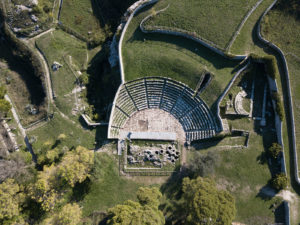In this lush territory rich in springs and watercourses, the Corinthians of Syracuse founded their first colony between 664 and 663 BC, which was named Akrai.
It was a fortress city for military and political control over the Sicels of the Hyblaean plateau.
As testified by literary sources, Akrai’s history is closely linked to that of Syracuse. Plutarch tells us that
Dion
stopped there in 357 BC on his march to Syracuse.
The colony is mentioned in the peace treaty between Rome and Syracuse of 263 BC at the beginning of the First Punic War. This period coincided with the height of the city’s splendour. In 214 BC, Hippocrates was hosted there after being defeated in the clash with the Romans. For Sicily, the period of Roman rule was generally a period of decadence, but this was not the case for Akrai.
This was when the city began to mint its own coins and assumed some economic importance in the region.